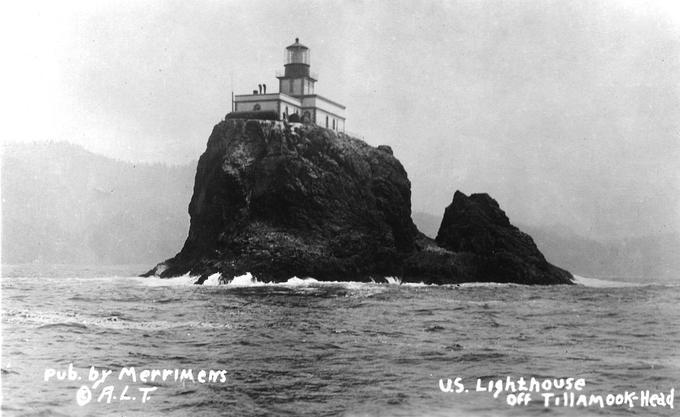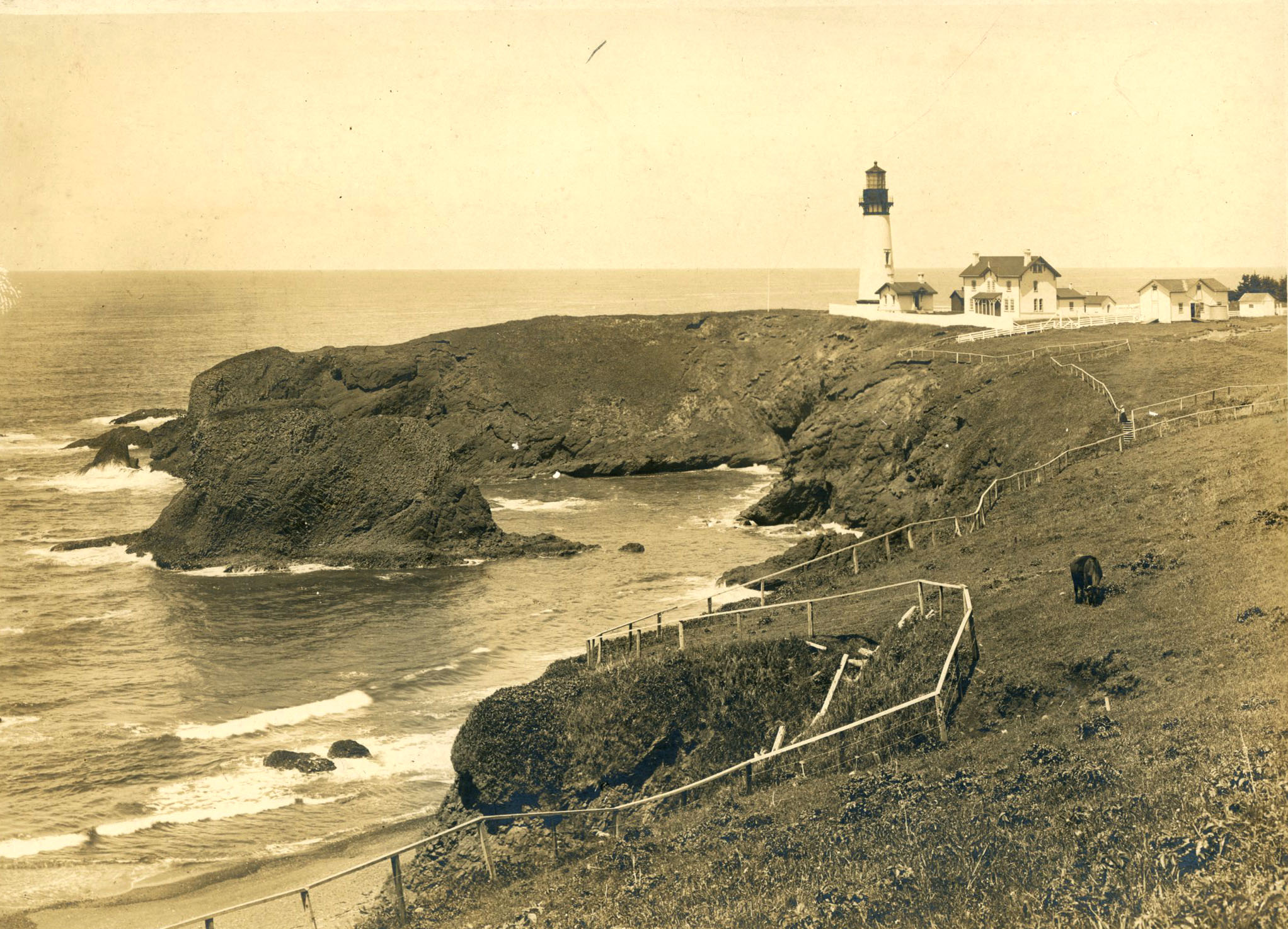The Umpqua River Lighthouse, Oregon’s first, was built twice. The U.S. Office of Coast Survey in 1849 selected the mouth of the Umpqua River as one of the first sixteen lighthouse locations for the West Coast. The survey sought to identify locations for a string of lighthouses detectible to mariners in a line-of-sight, leaving no stretch of the coast beyond visual range. This presented challenges on the south coast along the fifty-five miles from Cape Arago to Heceta Head, which is mainly a dune field lacking rocky promontories. The chosen spot was Umpqua’s low-lying, sandy north spit, roughly equidistant between those headlands.
Umpqua’s spit held promise. Since 1832, Hudson’s Bay Company operations in the Umpqua Basin, including Fort Umpqua near present-day Elkton, had enhanced the region’s economic status. In the wake of the California gold rush and passage of the 1850 Donation Land Claim Act, American commercial interests entered the lower Umpqua Valley with speculative ventures. By late 1850, survivors of the shipwreck Bostonian had founded the town of Gardiner in the estuary, and the Winchester Exploring Expedition had platted Umpqua City at the river’s mouth. A few months later, other towns were platted on the estuary, the bay gained a customs office, and gold mining began in the interior. By 1853, mining boomtowns had sprouted just south of the Umpqua.
Such developments prompted Congress to appropriate funds for an Umpqua River Lighthouse, with initial funds allocated in March 1851. Congress added supplementary appropriations in 1854, and construction began in 1855 with materials delivered from San Francisco.
The first Umpqua River Lighthouse was built in a war zone. Interethnic violence surged as miners flooded into southwest Oregon, and the U.S. government began the removal of lower Umpqua and other south coast tribes to the short-lived Umpqua Reservation and the incipient Coast Reservation—the precursor to the Siletz and Grand Ronde communities. A temporary facility on the Spit, within view of lighthouse construction, became the holding place for captured and detained Native people. Construction crews built the lighthouse and the U.S Army's Fort Umpqua concurrently, sometimes delayed by standoffs with Indians and visits from what local Indian agents termed “extermination-minded” miner militias.
The first lighthouse was in the Cape Cod style, with keepers’ quarters on either side of the 92-foot-tall tower. The first keeper was Fayette Crosby, a former Scottsburg hotelkeeper. The light, with its third-order Fresnel lens, was illuminated on October 10, 1857, the first on the Oregon Coast.
U.S. government officials lacked the ecological knowledge of local Natives and had a poor understanding of the dynamic, constantly shifting nature of the river’s mouth prior to jetty construction. An 1861 gale and river flood eroded the lighthouse’s foundation, and the building began to tilt. It was further undermined by a storm in October 1863, and the keepers, with official permission, abandoned the lighthouse in January 1864. The lens was taken out a week later. While dismantling the lantern room, workers had to flee for their lives when the tower began to totter and then crashed to the ground.
For more than thirty years, there was no lighthouse at the mouth of the Umpqua. The Lighthouse Board simply placed a buoy there. In 1888, Congress finally appropriated money for an Umpqua River lighthouse to fill the gap in the line-of-sight standard. This time, the lighthouse was built on a stable shelf of land some 165 feet above the south side of the river. But construction did not go smoothly: initial bids exceeded available funds, a major contractor went bankrupt, and the base for holding the Fresnel lens was fifteen inches too short, necessitating more congressional appropriations to correct the mistake.
Finally, in December 1894, Head Keeper Marinus Stream of Astoria lit the lamp, a beautiful first-order Fresnel lens (originally illuminated by oil lamp) manufactured by Barbier et Cie of Paris. The lighthouse had a signature beam of two white flashes and one red flash every fifteen seconds. Umpqua Lighthouse was a desirable post. Captain Andrew Hald had the longest tenure, serving as head keeper from 1899 to 1921.
After lighting the Douglas County coastline for eighty-nine years, the light’s chariot wheel apparatus, which turned the heavy lens, gave out. The Coast Guard installed a temporary beacon in the tower and proposed discontinuing use of the Fresnel lens. After local residents protested, the Coast Guard repaired the original mechanism, and the light went back into service in 1985. In 2010, the Coast Guard leased the lighthouse to Douglas County, and it is still in service under Coast Guard oversight as a Private Aid to Navigation.
The lighthouse remains on a U.S. Coast Guard Reservation, adjacent to Umpqua Lighthouse State Park. The historic U.S. Coast Guard Umpqua River Lifeboat Station, built in 1939 near the lighthouse, is now the Umpqua Lighthouse Museum, owned by Douglas County. The lighthouse and museum are slated to lose Douglas County funding as of July 2018 and are seeking private funding to maintain both facilities.
-
![]()
Umpqua River Lighthouse and State Park.
Courtesy Oregon Hist. Soc. Research Lib., 42419
-
![]()
Umpqua River Lighthouse.
Courtesy Oregon Hist. Soc. Research Lib., Acc 8067
-
![]()
Umpqua River Lighthouse, 1932.
Courtesy Oregon Hist. Soc. Research Lib., 015020
Related Entries
-
![Cape Arago Lighthouse]()
Cape Arago Lighthouse
The Cape Arago Lighthouse sits on a small island off Cape Arago, south …
-
![Cape Meares Lighthouse]()
Cape Meares Lighthouse
Cape Meares Lighthouse is located atop Cape Meares, a scenic craggy hea…
-
Coquille River Lighthouse
The Coquille River Lighthouse, which is adjacent to the Coquille River,…
-
![Desdemona Sands Lighthouse]()
Desdemona Sands Lighthouse
The U.S. Lighthouse Service completed Desdemona Sands Lighthouse in 190…
-
![Heceta Head Lighthouse]()
Heceta Head Lighthouse
Heceta Head Lighthouse stands 205 feet above the Pacific Ocean on a blu…
-
![Point Adams Lighthouse and Life-Saving Station]()
Point Adams Lighthouse and Life-Saving Station
Point Adams was given its name by Captain Robert Gray, who in his offic…
-
![Tillamook Rock Lighthouse]()
Tillamook Rock Lighthouse
Tillamook Rock Lighthouse sits on a rock a mile offshore of Tillamook H…
-
![Umpqua River]()
Umpqua River
The Umpqua River, approximately 111 miles long, is a principal river of…
-
![U.S. Life-Saving Service in Oregon]()
U.S. Life-Saving Service in Oregon
The mission of the U.S. Life-Saving Service was to rescue those in peri…
-
![Yaquina Bay Lighthouse]()
Yaquina Bay Lighthouse
Yaquina Bay Lighthouse, built in 1871, is currently the only wooden lig…
-
![Yaquina Head Lighthouse]()
Yaquina Head Lighthouse
The U.S. Lighthouse Board completed Yaquina Head Lighthouse in 1873 on …
Related Historical Records
Map This on the Oregon History WayFinder
The Oregon History Wayfinder is an interactive map that identifies significant places, people, and events in Oregon history.
Further Reading
Beckham, Stephen Dow. "Lonely Outpost: The Army’s Fort Umpqua." Oregon Historical Quarterly 70.3 (1969): 233-57.
Dicken, Samuel N. Some Recent Physical Changes on the Oregon Coast. Eugene, Ore.: Department of Geography, University of Oregon, 1961.
Gibbs, James, with Bert Webber. Oregon’s Seacoast Lighthouses. Medford Ore.: Webb Research Group, 1992.
Nelson, Ted and Sharlene. Umbrella Guide to Oregon Lighthouses. San Luis Obispo, Calif.: EZ Nature Books, 1994.
Pinyerd, David. Lighthouses and Life-Saving on the Oregon Coast. Charleston, S.C.: Arcadia Publishing, 2007.














